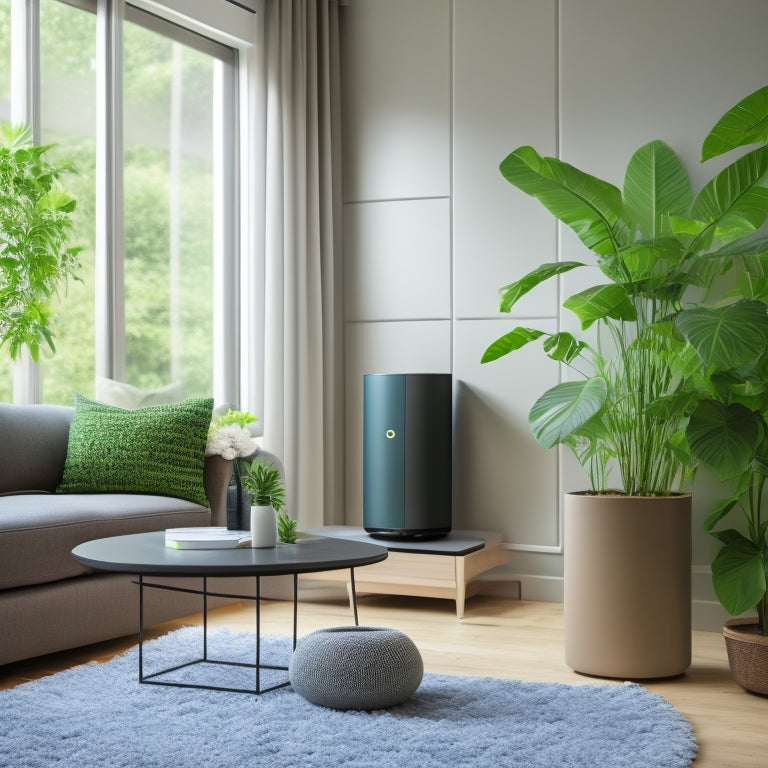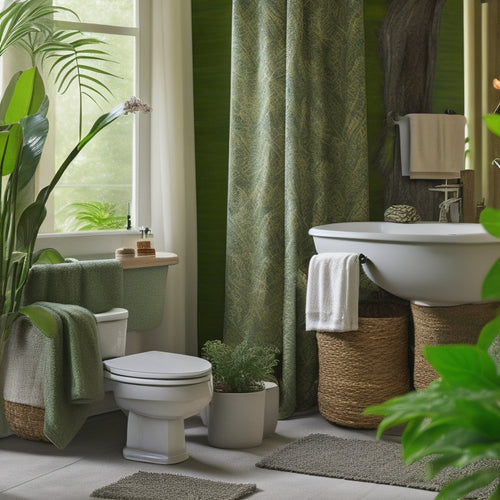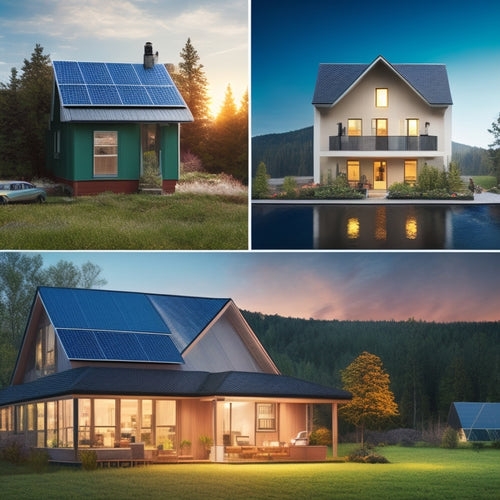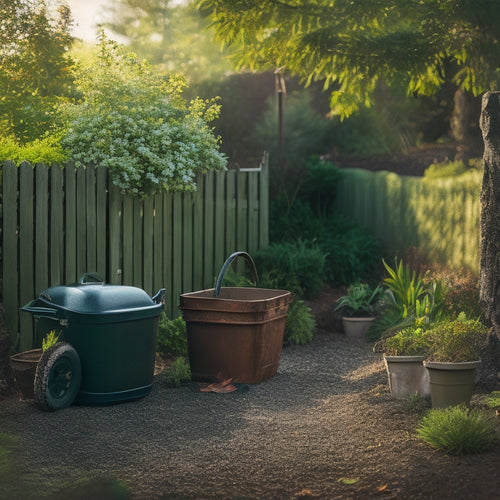
Boost Your Home's Air: Clean Living Tech Guide
Share
You spend 90% of your time indoors, where pollutants can accumulate and negatively impact your health. To enhance your home's air quality, it's vital to understand the importance of clean living technologies. Indoor plants, effective ventilation strategies, and air purifiers can help remove pollutants and allergens. However, selecting the right air purifier and understanding filter replacement costs are significant. By monitoring air quality, identifying pollution sources, and investing in purification systems, you can create a healthier living environment. Now, take the next step towards breathing easy and uncover the latest clean living tech solutions that can revolutionize your indoor space.
Key Takeaways
- Effective air purification involves selecting the right air purifier type, such as HEPA or activated carbon, based on room size and pollutant concerns.
- Regular filter replacements are crucial, with varying lifespans and costs for different filter types, to maintain air purifier effectiveness.
- Air quality monitoring with smart sensors and reliable air quality monitors helps track pollutants and informs decisions for a healthier living environment.
- DIY air quality improvement strategies, such as natural air purification methods and regular maintenance, can be simple and cost-effective.
- Whole house air purification systems require careful selection, regular maintenance, and consideration of factors like filtration technology and noise levels.
Air Quality Monitoring Essentials
As you steer through the complexities of clean living, it's essential to understand the importance of monitoring the air you breathe.
You spend most of your time indoors, where pollutants can accumulate and negatively impact your health. To combat this, incorporate indoor plants that naturally purify the air, such as peace lilies or spider plants.
Additionally, consider the benefits of electric vehicles, which can save up to $14,500 on fuel costs and reduce your carbon footprint.
Implement effective ventilation strategies, like opening windows or using whole-house fans, to circulate fresh air and remove stale air.
Choosing the Right Air Purifier
You're now ready to select an air purifier that effectively addresses your indoor air quality concerns.
Contemplate integrating solar power into your home to reduce your carbon footprint and energy bills, just like rooftop solar panels that provide clean energy for EV charging.
To make an informed decision, you'll need to reflect on the different types of purifiers available, including HEPA, activated carbon, and UV-based models.
Additionally, you'll want to think about the size of the room you want to purify and the ongoing costs of replacing filters to guarantee peak performance.
Purifier Types Compared
Your air quality depends on the type of air purifier you choose, and with so many options available, selecting the right one can be overwhelming.
Considering the importance of reducing air pollution, which is also a key benefit of Electric Vehicles reducing air pollution, HEPA filters offer benefits like trapping 99.97% of particles as small as 0.3 microns, making them ideal for allergy sufferers.
UV light purifiers are effective against germs and bacteria, but may not remove particles.
Ionizers, which use negative ions to attract pollutants, raise safety concerns due to ozone production.
Activated carbon purifiers excel at removing gases, odors, and chemicals, but may not capture smaller particles.
Ozone generators, while effective against strong odors, pose health risks due to ozone exposure.
Consider your specific needs and prioritize features to find the best air purifier for your home.
Room Size Considerations
The square footage of your living space is a critical factor in selecting an air purifier that effectively cleans the air. You need to take into account the room dimensions and airflow patterns to guarantee the purifier can handle the space.
Incorporating eco-friendly practices, such as solar-powered solutions, can further enhance air quality and reduce carbon footprint. Measure your room's length, width, and height to calculate its cubic feet.
Check the air purifier's coverage area, usually specified in square feet or cubic feet. Contemplate the room's layout, including obstacles that might hinder airflow.
Look for an air purifier with adjustable fan speeds to customize airflow for your space.
Filter Replacement Costs
Uncover the hidden costs of air purifier maintenance: filter replacements. When choosing an air purifier, you'll need to take into account the type of filter and its replacement schedule. Different filter types have varying lifespans and costs.
| Filter Type | Lifespan | Replacement Cost |
|---|---|---|
| HEPA | 6-12 months | $20-$50 |
| Activated Carbon | 3-6 months | $10-$30 |
| Ionizer | N/A | $0 (none required) |
| Hybrid | 6-12 months | $30-$60 |
| Smart Filter | 12-18 months | $50-$100 |
You'll want to factor these costs into your overall budget to guarantee you're getting the best value for your money. By understanding the maintenance needs of your air purifier, you can breathe easy knowing you're getting the clean air you deserve.
Top Air Quality Monitors Compared
Breathing in polluted air can silently sabotage your health, making it vital to keep tabs on the air quality in your home. You need a reliable air quality monitor to alert you to potential threats.
As electric vehicles become increasingly popular, it's essential to prioritize safety protocols, such as establishing strict safety guidelines, to mitigate hazards associated with high-voltage systems.
Top brands like Awair, Levoit, and Honeywell offer user-reviewed monitors that track PM2.5, VOCs, and other pollutants. Consider the following top air quality monitors:
- Awair Element: Tracks indoor and outdoor air quality, with a sleek design and user-friendly app.
- Levoit Smart Air Purifier: Combines air quality monitoring with a built-in air purifier for thorough air cleaning.
- Honeywell HPA300: Offers advanced allergen and odor detection, with a large LCD display for easy reading.
- Foobot: Monitors air quality and provides personalized recommendations for improvement, with a compact and portable design.
Smart Sensors for Healthier Homes
Over 90% of our lives are spent indoors, where hidden dangers like mold, humidity, and temperature fluctuations can silently compromise our health.
That's why smart sensors are crucial for creating a healthier home environment. These devices provide accurate readings of your home's air quality, temperature, and humidity levels, giving you real-time data to make informed decisions.
With smart home integration, you can receive alerts and notifications when levels exceed safe thresholds, allowing you to take prompt action.
Look for sensors with high sensor accuracy, such as those using laser-based detection, to guarantee reliable results.
Purification Systems for Allergies
Airborne allergens like dust, pollen, and pet dander can wreak havoc on your respiratory system, making every breath a struggle.
If you're tired of feeling held back by allergy triggers, it's time to contemplate a purification system designed to combat allergies.
These systems can provide numerous purification benefits, including:
- Capturing 99.97% of particles as small as 0.3 microns, including dust, pollen, and pet dander
- Reducing allergy symptoms like congestion, sneezing, and itchy eyes
- Eliminating strong odors and gases that can exacerbate respiratory issues
- Creating a cleaner, healthier breathing environment for you and your family
DIY Air Quality Improvement Tips
You can greatly improve your indoor air quality without relying on expensive systems.
By purifying the air naturally, eliminating hidden pollutants, and taking simple steps to breathe easy at home, you'll be well on your way to creating a healthier living space.
Start by identifying and tackling the sources of pollution in your home, and then implement simple, effective DIY strategies to purify the air and keep it clean.
Purify the Air Naturally
Indoor pollutants like volatile organic compounds (VOCs) and particulate matter (PM) can greatly degrade air quality, exacerbating respiratory issues and other health problems.
You can take control of your home's air quality by adopting natural air purification methods.
-
Add natural air fresheners like baking soda, activated charcoal, or essential oils to absorb impurities and odors.
-
Incorporate indoor plants like peace lilies, spider plants, or aloe vera, which are known to remove VOCs and PM from the air.
-
Increase ventilation by opening windows or using fans to circulate air.
- Use a dehumidifier to reduce moisture, which can contribute to mold growth and poor air quality.
Eliminate Hidden Pollutants Now
Beyond natural air purification methods, hidden pollutants in your home can still compromise air quality. You must identify and eliminate these hidden sources to breathe easy.
Start by detecting pollutants like dust, mold, and chemical exposure from cleaning products or pesticides. Implement ventilation strategies like opening windows or using fans to improve air circulation and reduce indoor humidity.
Indoor gardening can also help, but be mindful of dust accumulation on plants. Focus on allergen reduction by regularly cleaning and dusting surfaces.
Breathe Easy at Home
Air quality improvement begins at home, where a few simple tweaks can make a significant difference. You can take control of the air you breathe by implementing some easy DIY strategies.
Start by incorporating indoor plants, which are natural air purifiers, into your home decor.
- Open windows and doors to let fresh air in, especially after cooking or showering
- Use exhaust fans in the kitchen and bathroom to remove pollutants
- Replace carpeting with hardwood or tile flooring to reduce dust and allergens
- Create a ventilation strategy by upgrading to a HEPA air purifier or installing a whole-house fan
Indoor Pollution Sources Exposed
You breathe in, thinking you're safe from pollution's grasp, but toxic substances lurk in every corner of your home.
Furniture emissions, mold spores, and pet dander are just a few culprits contaminating your air.
Cleaning chemicals, cooking fumes, and indoor smoking further exacerbate the problem.
Building materials, such as paint and flooring, can release volatile organic compounds (VOCs) into the air.
Humidity levels that are too high or too low can also contribute to poor air quality.
Even your air vents and ventilation systems can harbor pollutants if not properly maintained.
It's time to take control of your indoor air and identify these hidden hazards.
Whole House Air Purification Systems
Within the walls of your home, an all-encompassing approach to air purification is vital to combat the multitude of indoor pollution sources. A whole house air purification system is a thorough solution that guarantees clean air circulates throughout your living space.
-
System efficiency is key, so consider factors like installation tips, air quality, and energy consumption when selecting a system.
-
Regular maintenance guides and cost analysis will help you optimize your system's performance and budget.
-
Filtration technology plays a significant role in capturing airborne pollutants, providing major health benefits.
- Be mindful of noise levels, as some systems can be noisy, and opt for one that suits your needs.
Air Cleaning Technologies Explained
Break down the complex process of removing impurities from your indoor air by delving into the core technologies behind air cleaning. These innovative solutions work together to create a healthier breathing space.
| Technology | How it Works | Benefits |
|---|---|---|
| UV Sterilization | Uses ultraviolet light to kill germs and viruses | Eliminates 99.9% of bacteria and germs |
| Ionization | Releases negative ions to attract and trap pollutants | Reduces airborne particles and odors |
| HEPA Filters | Captures 99.97% of particles as small as 0.3 microns | Removes allergens, dust, and pet dander |
| Electrostatic Precipitators | Uses electrostatic charges to trap particles | Effective against smoke, dust, and pollen |
| Photocatalytic Oxidation | Breaks down pollutants using light-activated catalysts | Neutralizes gases, odors, and VOCs |
Understanding these air cleaning technologies enables you to make informed decisions about your indoor air quality, giving you the freedom to breathe easy.
Green Living With Clean Air
Clean air isn't just about removing impurities; it's also about living in harmony with the environment.
By incorporating eco-friendly habits into your daily routine, you can create a green home that not only improves air quality but also reduces your carbon footprint.
Here are some ways to achieve this:
- Choose sustainable materials for your furniture and decor to reduce pollutants and toxins.
- Bring in some greenery with indoor plants, which can help purify the air naturally.
- Opt for natural ventilation by opening windows and using fans instead of air conditioning.
- Invest in energy-efficient appliances and lighting to reduce energy consumption and promote a healthier indoor environment.
Frequently Asked Questions
Can Air Purifiers Remove Viruses and Bacteria From the Air?
You'll be concerned to know that 90% of our time is spent indoors, where air can be 2-5 times more polluted than outdoors. Yes, air purifiers can remove viruses and bacteria from the air, but it depends on filter efficiency, and reducing virus transmission requires a thorough approach.
Do Air Quality Monitors Detect Carbon Monoxide Levels?
You're wondering if air quality monitors can detect carbon monoxide levels? Yes, they can! Many air quality monitors measure carbon monoxide detection alongside other air quality measurements, providing you with a thorough overview of your indoor air quality.
Are Air Purifiers Loud and Disruptive to Daily Life?
You'll be shocked to learn that 90% of people spend 90% of their time indoors, where air pollution can be 5x worse! Air purifiers can be loud, but placing them strategically can minimize noise levels, ensuring a disruption-free life.
Can Air Pollution in the Home Cause Skin Issues?
You expose yourself to indoor allergens daily, increasing skin irritation risks; airborne pollutants like particulate matter, VOCs, and ozone can penetrate skin, triggering inflammation, acne, and premature aging, making clean air essential for a healthy, radiant complexion.
Do Plants Really Improve Indoor Air Quality Effectively?
You'll be relieved to know that certain plant types, such as peace lilies and spider plants, can effectively improve indoor air quality by removing pollutants, enhancing oxygen levels, and creating a healthier breathing space for you.
Related Posts
-

Sustainable Scrubbing: Top Bathroom Solutions for Earth-Conscious Homes
You're taking an important step towards creating a more sustainable home by switching to eco-friendly bathroom cleani...
-

What Does Your Home Energy Audit Report Reveal?
Your home energy audit report reveals a detailed analysis of your energy consumption patterns, highlighting areas of ...
-

10 Green Waste Solutions Every Homeowner Should Know
You can make a significant impact on the environment by implementing green waste solutions at home. Consider composti...


